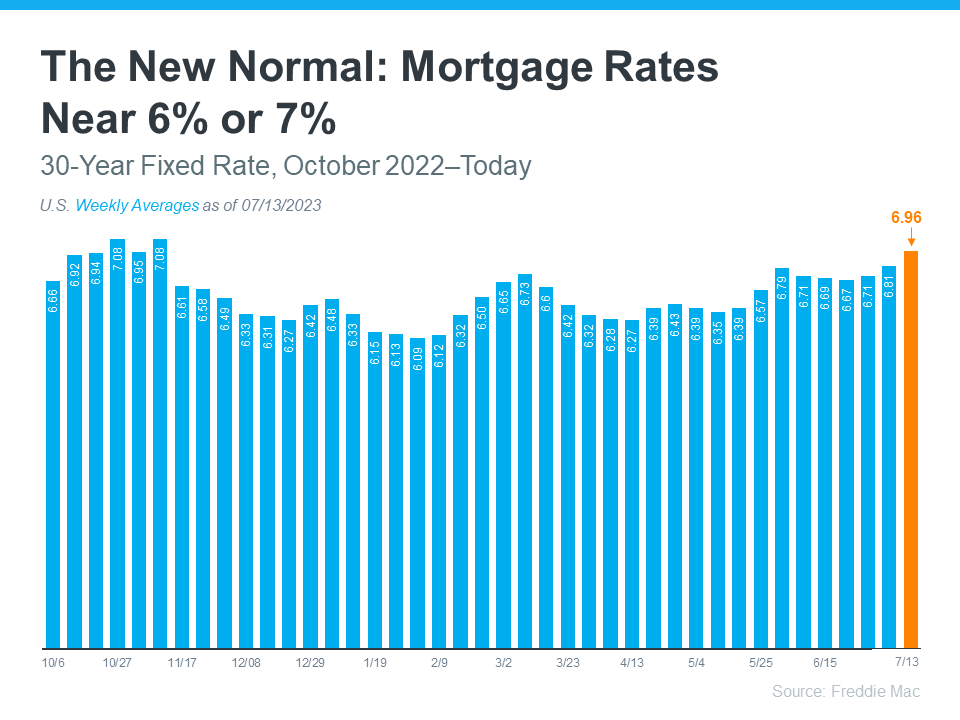Before you decide to sell your house, it’s important to know what you can expect in the current housing market. One positive trend right now is homebuyers are getting used to the new normal and adapting to today’s mortgage rates.
To better understand what’s been happening with mortgage rates lately, the graph below shows the trend for the 30-year fixed mortgage rate from Freddie Mac since last October. As you can see, rates have been between 6% and 7% pretty consistently for the past nine months:
According to Lawrence Yun, Chief Economist at the National Association of Realtors (NAR), mortgage rates play a significant role in buyer demand and, by extension, home sales. Yun highlights the positive impact of stable rates:
“Mortgage rates heavily influence the direction of home sales. Relatively steady rates have led to several consecutive months of consistent home sales.”
As a seller, hearing that home sales are consistent right now is good news. It means buyers are out there and actively purchasing homes. Here’s a bit more context on how mortgage rates have impacted demand recently.
When mortgage rates surged dramatically last year, escalating from roughly 3% to 7%, many potential buyers felt a bit of sticker shock and decided to hold off on their plans to purchase a home. However, as time has passed, that initial shock has worn off. Buyers have grown more accustomed to current mortgage rates and have accepted that the record-low rates of the last few years are behind us. As Doug Duncan, SVP and Chief Economist at Fannie Mae, says:
“. . . consumers are adapting to the idea that higher mortgage rates will likely stick around for the foreseeable future.”
This is good news because while 3% was an amazing interest rate for home buyers to be able to get it was also an aberration. In fact, the current 30-year fixed rate is still relatively low in the historic scheme of things — though it may not feel that way, given its rapid rise in 2022 (doubling in a matter of months).
For some perspective, in the 1970s rates averaged almost 10%. In the 1980s the average was around 14%. While during the 1990s and 2000s rates averaged 7%. It wasn’t until the 2010s that rates averaged 4%. The rate was that low because the Federal Reserve was trying to help the country recover from the 2008 dual housing and banking crises. As a response to the Covid pandemic, the Federal Reserve once again massively cut rates to spur an economic recovery. In other words, today’s mortgage interest rates are actually not high and home buyers are starting to realize that 6% is not a reason to not buy a home.
In fact, a recent survey by Freddie Mac reveals 18% of respondents say they’re likely to buy a home in the next six months. That means nearly one out of every five people surveyed plan to buy in the near future. And that goes to show buyers are planning to be active in the months ahead.
Of course, mortgage rates aren’t the sole factor affecting buyer demand. No matter where mortgage rates stand, people will always have reasons to move, whether it’s for job relocation, changing households, or any other personal motivation. As a seller, you can feel confident there is a market for your house today. And that demand is pretty strong as buyers settle into where rates are right now.
Bottom Line
The way buyers perceive today’s mortgage rates is shifting – homebuyers are getting used to the new normal. Steady rates are contributing to strong buyer demand and consistent home sales. So, if you’re ready to sell your house, let’s connect so we can get your house on the market and in front of those buyers.



